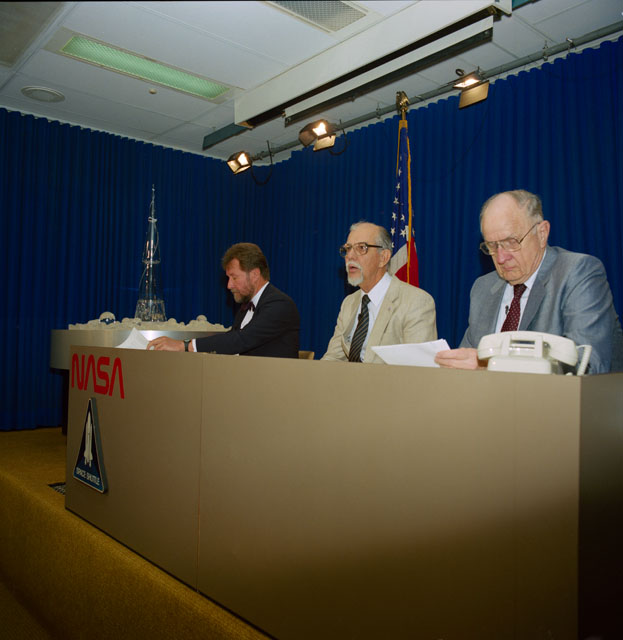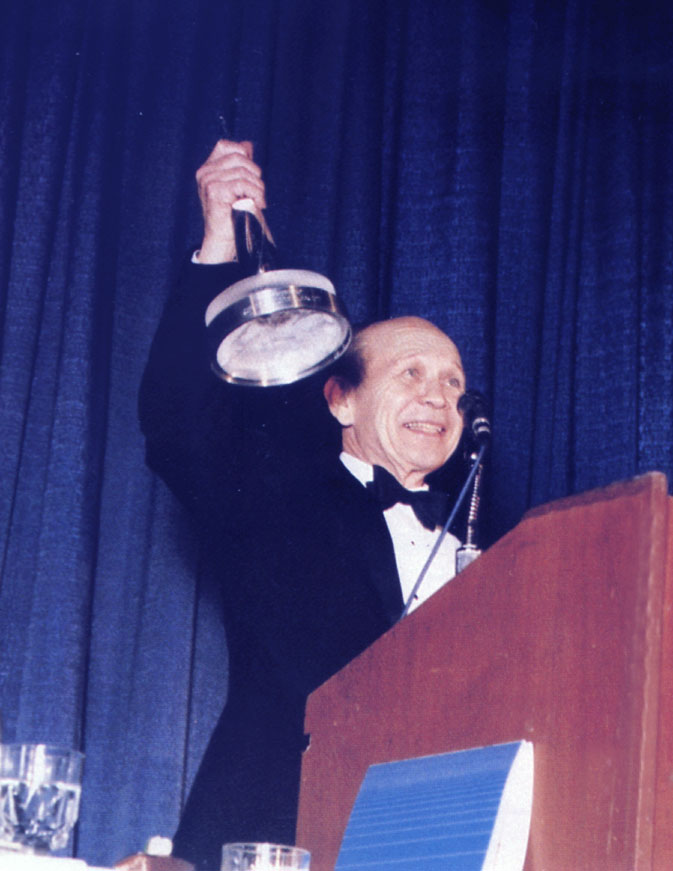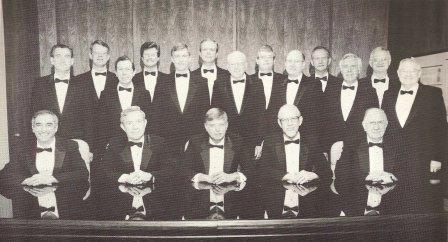History of Space Achievement
By Marianne Dyson
See the National Space Trophy Winners page for biographies of past winners, the Stellar Awards page for past Stellar Winners, the Agenda pages for speakers of past events, the Communicator Awards page for Space Communicator Winners, the Press Information for previous press releases, and the Photo Gallery for images from past years.

Charles Hartman and Owen Morris announce the new National Award for Space Achievement
Initiating a new national award was as full of challenges as space itself. For the award to have the desired prestige, the committee decided that everything should be first class, starting with the trophy. Steuben Glass of New York proposed a breathtakingly beautiful trophy design. Raising over $35,000 for the 500-pound, four-foot tall custom lead crystal presented the first of many challenges. According to Wren some of the other challenges included "establishing a foundation, creating contact lists, creating a board of advisors, creating a nomination/selection process, making hotel/dinner/program arrangements, and establishing goals for the annual event."
Hartman and Morris recruited the people with contacts and necessary knowledge to meet the challenges. One of these was former NASA manager Jack Lister. He said in a recent interview that, "The idea for this program was so powerful and exciting that I do not believe that we ever had a problem sustaining interest or getting outstanding volunteer support." He should know - he's been on the board for all twenty years, as has Robert Wren. Other early recruits included NASA employees Ron Blilie, Al Jowid, and Robert Mitchell; Air Force officers Harold Neely (1910-1995) and John Watson; contractor employees Chuck Jacobson, Frank Morgan, and Sam Boyd; University of Houston Provost Charles Hardwick; and Rotarians John Francis, Billy Smith (who served as their attorney), Don Kirk, Floyd Boze, Lamar Bowles, and Terry Stock.
Lister spearheaded the creation of an Advisory Board of space experts and managers to review nominations on a national basis to select the trophy winners each year. The original 32 advisors included NASA center directors, presidents of companies and universities, military commanders, members of the news media, astronauts and political leaders. The current board includes leaders from all of these areas plus previous award winners. Though their titles and affiliations have changed since 1987, seven of the original advisors served on the board at its twentieth anniversary in 2006 including; Jim Asker; Norman Augustine; Aaron Cohen; Gerald Griffin; Christopher Kraft; Robert McCall; Harrison Schmitt; and Richard Truly. Four of these individuals were selected by their peers to be recognized with the National Space Trophy: Truly (1989), Cohen (1991), Augustine (1992), and Kraft (1999).

Max Faget
In 1989, the RNASA Foundation expanded its award program to include Stellar Awards to recognize the important contributions of the "unsung heroes" of the space program. The first Stellar Awards was presented to Charles (Chuck) Biggs of the NASA JSC Public Affairs Office "on behalf of the millions of persons around the world to whom he has made the excitement of space exploration a reality." Four Stellar Awards were given in 1989, 1990, and 1991 in various categories including news media, academia, military service, spacecraft processing, legislative support, and life sciences. In 1992, a Corona award for lifetime achievement was presented to Robert Gilruth. More Stellar Awards by categories were given out in 1995 and 1996, and a Corona for lifetime achievement was awarded to John Young in 1997 and Walter Cronkite in 1999.
In 1997 the categories and nomination process for Stellar Awards were expanded to recognize a more diverse group of people at all stages of their careers. Subject categories were replaced with age groups plus teams. Nominations were sought from leaders in industry, government, and the military. The nominees are ranked by an Evaluation Committee chosen by the RNASA Board of Directors. This is the tenth year that former JSC center directors Aaron Cohen and Chris Kraft have served as evaluators. Others include Pete Aldridge, George Bekey, Max Faget, Bill Muhlberger, Al Diaz, John O'Neill, and Glynn Lunney (now in his third year on the committee). The number of nominees has grown from seventy in 1997 to 127 this year.
When asked at the 20th anniversary event in 2006 to name one of the most memorable events, Lister said, "Unquestionably, the dinner in 1998 to recognize President George Bush was my most memorable. This dinner was the largest attended (approx. 800) and attracted many high officials from government and industry alike. I believe this dinner helped entrench the credibility and importance of this program as a national entity."
To Wren the first award to Max Faget and the Corona Award to Robert Gilruth were especially memorable. Jeffrey Carr, RNASA Advisor and Director of Public Relations for United Space Alliance, remembered Tommy Holloway's acceptance speech in 2001 "He went on and on about his gratitude for his wife, his family and the values that guided him in life and in his career. It reminded me of how this program is built on the sacrifice and perseverance of so many people."
Many years have passed since Owen Morris had the vision to establish a Stellar Awards program to celebrate and recognize the many benefits of space exploration. He could never have done it without the "Service Above Self" attitude of the Space Center Rotary Club and the many generous sponsors who understand the vital role the space program plays in our lives. "I think the single greatest impact of these Stellar Awards is to remind all those who attend that they are part of a very special family—space explorers," Carr said. "The exploration of space is still very much in its infancy. And to celebrate the career accomplishments of working engineers, scientists, technicians and communicators alongside the very legends of space reinforces that kinship and with it, the pioneering spirit that drives us all."
Floyd Bennett joined Space Center Rotary and RNASA in 1995. As RNASA President in 2006, Bennett said, "We are continuing the original goals of Morris & Hartman with nominations of people who have made a difference in the U. S. Space Program, and by presenting, with the help of our sponsors and production team, an event applauded as 'most prestigious'."
The RNASA Foundation committee thanks and congratulates all the volunteers, supporters, and award winners who have made the Rotary National Award for Space Achievement the premier Stellar Awards program in the field of space exploration.
This article is based on the 20th anniversary history written by Marianne Dyson and published in the March 24, 2006 RNASA souvenir program book.

